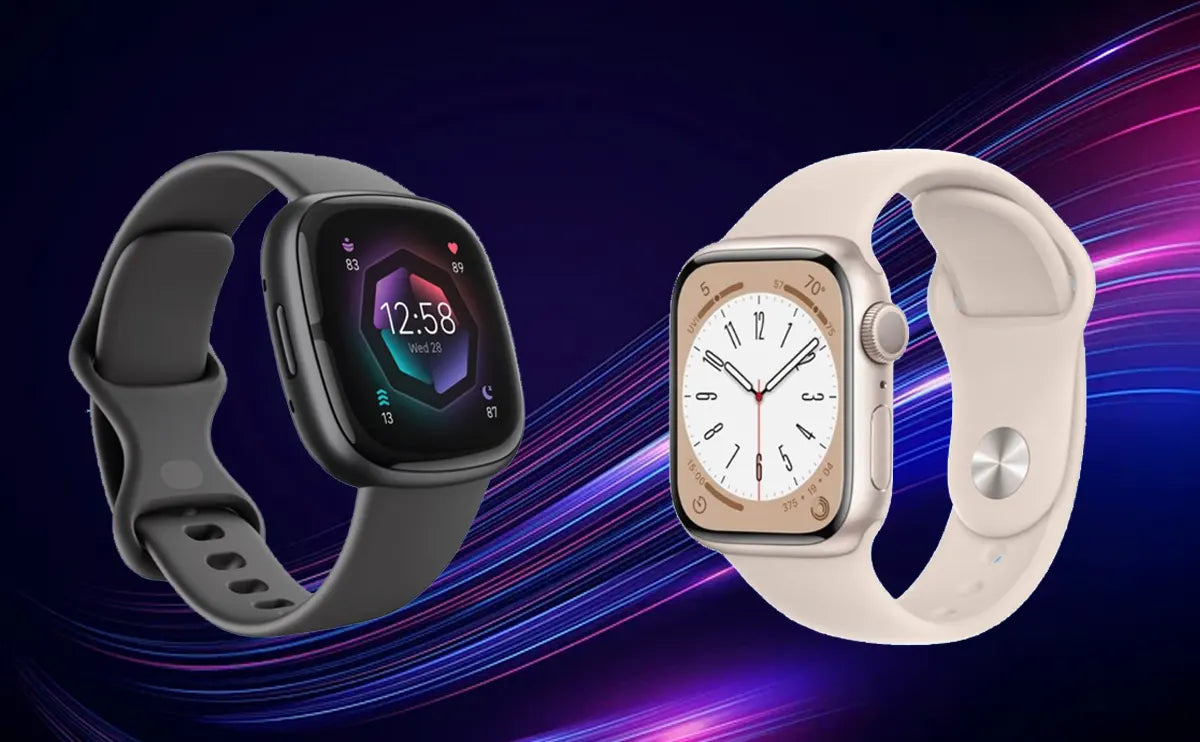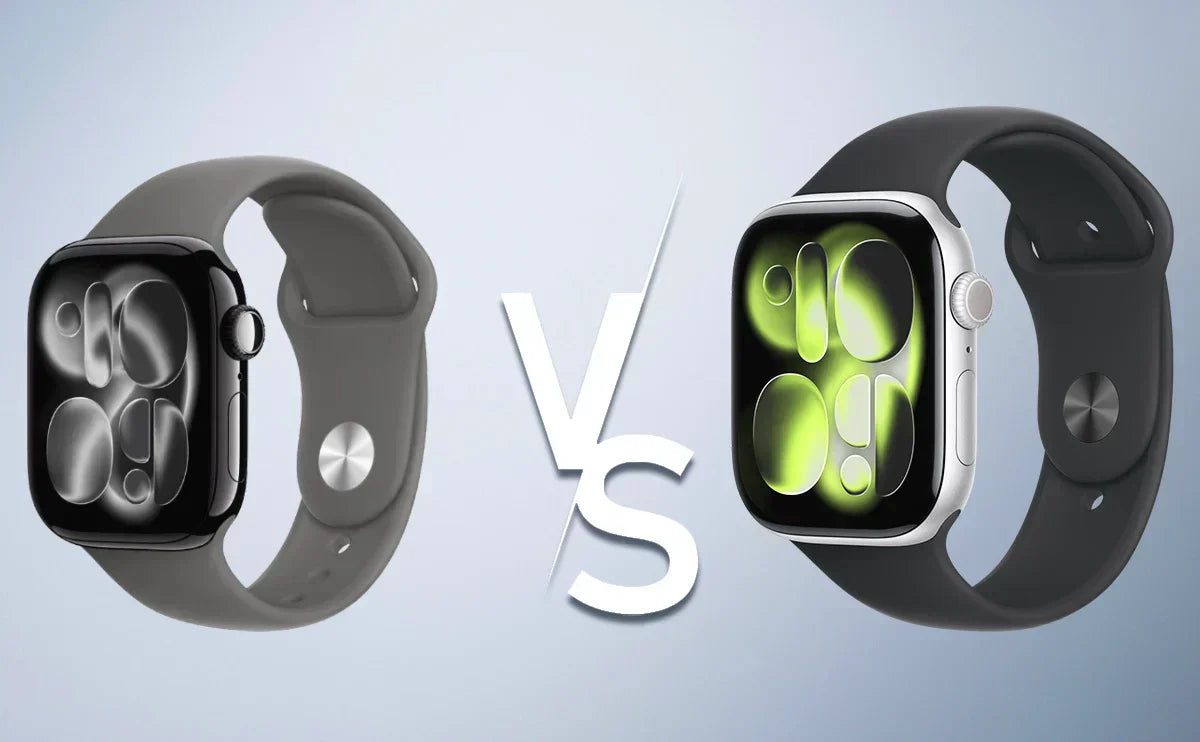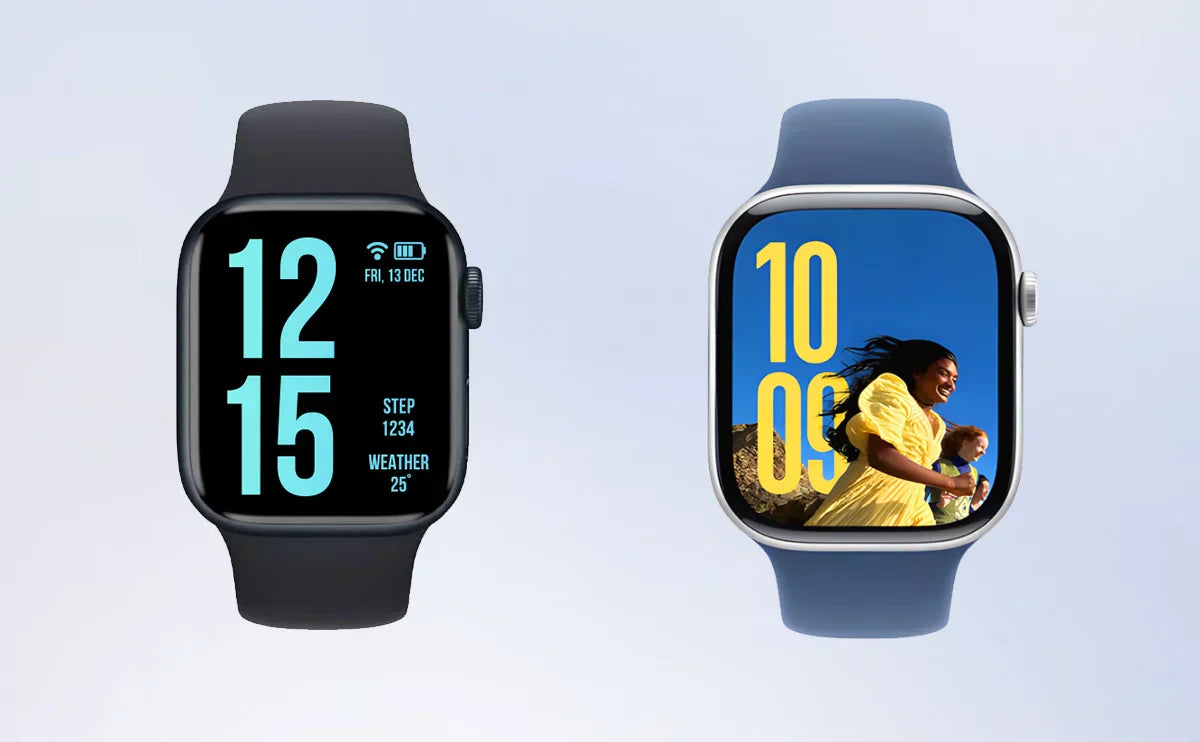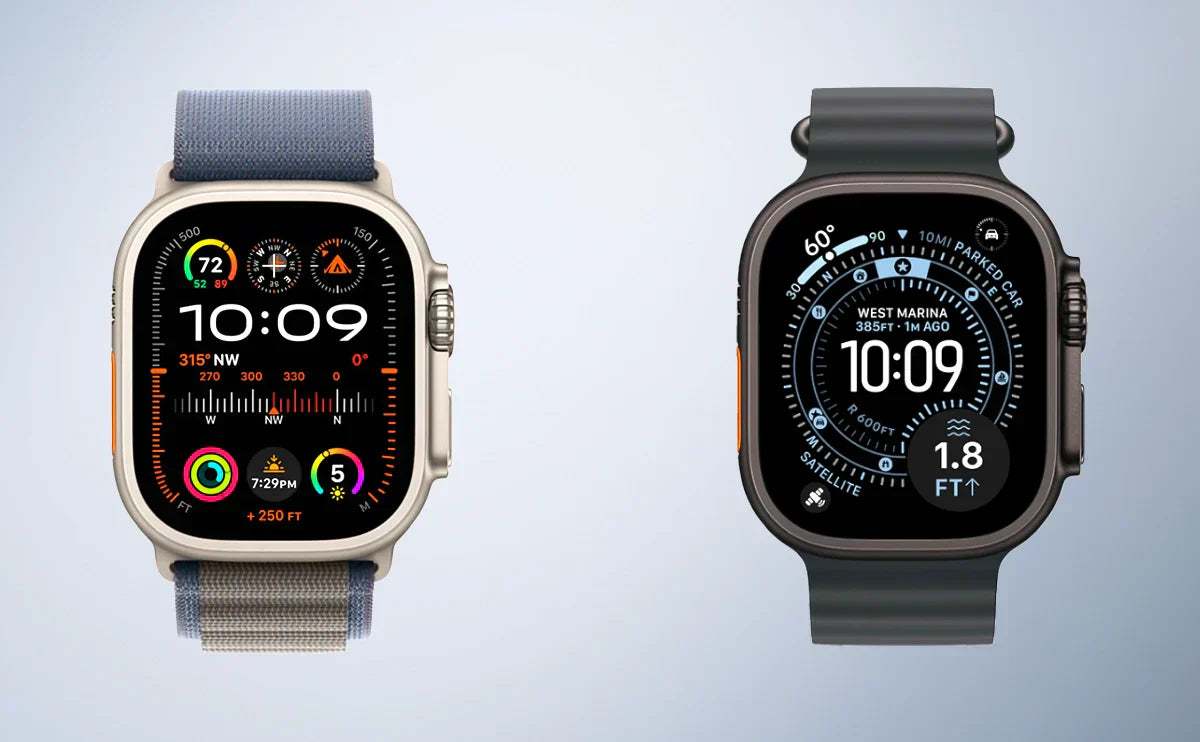Main content:
- Design and comfort
- Where else will you be paying attention to your fitness goals?
- Battery life
- Smart features and ecosystem
- Price
- Fitbit and Apple Watch - advantages and disadvantages
- Best practices for use
- FAQs About Fitbit vs. Apple Watch
- What is the main difference between them regarding their own fitness tracking?
- Am I allowed to use Fitbit using iPhone?
- Does my watch need an iPhone?
- Which smartwatch lasts longer?
- Is either device water resistance?
- Culmination
Smartwatches are changing the way we track fitness, monitor our health, and generally stay in touch. With the big competitors who also carry it today, there are very few standing above the rest. Just as Garmin vs Apple Watch sparks debates among fitness enthusiasts, Fitbit and Apple Watch continue to shine as each represents a different pace of life. So which one would it be?
Choosing between these two giants makes things overwhelming because of their innovative designs, as well as how capable the devices are. This is an in-depth look at important differences - ranging from fitness tracking accuracy and compatibility with the ecosystem to help you identify the best smartwatch for the purpose that matters most to you.
Are you an athlete looking for that perfect performance? Are you a professional that demands seamless connectivity? Or perhaps someone focused on better health? It all matters because Fitbit shines with advanced fitness tracking and all-day battery life, while Apple Watch makes its mark with unparalleled features in the ecology.
With this all-inclusive comparison, you will have everything you'll need to know in order to make your choice. It is not just tech; it is the companion you want to supplement everyday life, motivate you, and keep on course. Keep reading for the ultimate showdown between Fitbit and Apple Watch. Which wearable fits your lifestyle and needs best?
Design and comfort
The design of a smartwatch goes a long way in integrating it into your lifestyle.
Apple Watch
The square Retina watch face, available in three premium finishes—aluminum, stainless steel, and titanium—delivers both style and functionality. With the always-on OLED screen, you can effortlessly view notifications and fitness metrics as they arrive.
Whether you're comparing Apple Watch Ultra vs. Ultra 2 for durability and advanced features, or debating Apple Watch Series 8 vs. 9 for their refined upgrades, the lineup offers options to suit every preference. The Apple Watch Series 9 vs. Ultra 2 comparison highlights the balance between sleek sophistication and rugged versatility. With interchangeable straps and a clean, modern design, the Apple Watch makes a statement that’s as fashionable as it is technologically advanced.
Fitbit
Fitbit focuses on being versatile and not cumbersome, with minimalist designs that make you want to wear them all day. Models such as the Fitbit Sense 2 and Versa 4 come with soft silicone straps and a touchscreen interface. Fitbit doesn't boast of one of the best displays; whatever there is available, however, is made plain and clear.

Where else will you be paying attention to your fitness goals?
Fitness and health is the main reason people spend money on smartwatches. Here’s a look at how Fitbit vs. Apple Watch stack up, tailored to this specific use case.
Fitbit
Fitbit is a brand synonymous with fitness tracking, with popular models such as Fitbit Charge 5, Fitbit Versa 4, Fitbit Sense 2, and Fitbit Inspire 3 leading the way in innovation. It offers the following:
- Heart Rate Monitoring: tracks resting, active, and maximum heart rate
- Sleep Tracking: depth and quality
- Stress Management: offers EDA sensors to track signs of stress
- Fitness Modes: suitable for all types of activities, whether running and yoga.
Fitbit has leveraged its app to present data in an accessible fashion, that much it is a favorite among fitness enthusiasts who need actionable information.
Apple Watch
The Apple Watch affords the ubiquitous approach to integration of fitness and lifestyle features. With models like Apple Watch SE 2, Apple Watch Series 8, Apple Watch Series 9, Apple Watch Series 10, and Apple Watch Ultra 2, the lineup continues to redefine what's possible in wearable technology. The features are:
- Activity Rings: A gamified system very telling and keeping a user striving for closure of the rings on standing, movement, and exercise.
- Blood Oxygen Monitoring: A measure for oxygen saturation in health monitoring.
- ECG App: Enables users to monitor their heart rhythms and detect irregularities.
- Guided Workouts: video-led guided workout sessions are provided by Apple Fitness+
- Motivates Apple Watch: A great motivator and just perfectly fits the thought of merging fitness tracking with entertainment and personal goals set in the watch.
Battery life
Battery life is generally a main consideration when it comes to choosing the best smartwatch.
Fitbit
Top of the list for this brand is Fitbit. Fitbit products even offer up to 6 days of battery life in models like the Sense 2. That is long enough for a user who doesn't want to find themselves frequently recharging. The added convenience of Quick Charging makes it such that the user doesn't have to wait to get on with their affairs.
Apple Watch
Apple Watch lasts up to 18–24 hours of mixed usage. This is enough to get through daily activities but requires charging every night, especially in applications such as an always-on display and frequent use of the built-in GPS tracker. Its fast charging somewhat offsets the need to charge it as often.

Smart features and ecosystem
Apple Watch
Direct integration into the Apple ecosystem with features such as:
- Handoff: move things between Apple devices
- Siri: voice commands for navigation and tasks.
- Contactless Payments: Secure contactless payments from your wrist with Apple Pay
- Integration with iPhone: Its tight integration with iPhones makes the Apple Watch a natural choice for Apple users.
Fitbit
Fitbit has cross-platform compatibility, so it works nicely on both Android and iOS, which makes it easier for the masses to use. Focus on health and direct simplicity help make this accessible to a wider audience. Newer models run on Google's Wear OS, allowing for way more apps and smoother functionality.
Price
Fitbit has also showcased its products at varied price points, such as cheap fitness bands and stylish smartwatches. Yes, it is a bit expensive, but the Apple Watch helps in earning one dollar for its price value by bringing a difference in terms of material usage, advanced features, and integration.

Fitbit and Apple Watch - advantages and disadvantages
Fitbit Pros
- Battery life - up to 6 days.
- Perfectly developed fitness tracking feature, detailing stress, sleep quality, and many.
- Cross-platform compatibility
- Light in weight, ergonomic design.
- Value for money: Offers different types of products within different budget ranges.
Fitbit Cons
- Fewer features on the smartwatch compared to Apple Watch.
- The display does not shine very bright.
- The apps are not as many on the Fitbit app ecosystem.
Apple Watch Pros
- Premium design with the ability to interchange bands.
- High-class intelligent features and app ecosystem.
- Comes with a seamless integration in the ecosystem.
- Fitness motivating tools like the rings of activity.
- It has fast charging.
Apple Watch Cons
- Its battery life is short and only lasts to about 18–24 hours.
- Does not have compatibility with Android gadgets.
- It is costly.

Best practices for use
Fitbit Best Practices
- Change Goals: This should be done through the Fitbit app. Here one will set fitness and wellness goals.
- Wear It Overnight: Get sleep tracking insights by wearing Fitbit at night.
- Update Regularly: Stay on the latest firmware for new features and higher accuracy.
- Sync Daily: Stay synced with the app to have your data categorized and actionable.
- Explore Advanced Metrics: Explore stress management and SpO2 readings for a holistic view of health.
Apple Watch Best Practices
- Close Your Rings: To stay motivated and hit fitness goals, use the activity rings.
- Leverage Ecosystem: Pair with other Apple devices for an even more seamless experience.
- Charge Daily: Charge your watch daily, preferably overnight.
- Turn On Focus Mode: Use Focus Mode to minimize distractions during your workout sessions.
- Try Fitness+: Take advantage of Apple Fitness+ workouts designed for your fitness goals.

FAQs About Fitbit vs. Apple Watch
What is the main difference between them regarding their own fitness tracking?
Fitbit remains the king of the app market for fitness and health tracking; it has metrics for activities, sleep, and stress. Apple Watch is all-rounded with motivational apparatuses, including activity rings.
Am I allowed to use Fitbit using iPhone?
Yes, Fitbit incorporates iOS and Android, that makes it an excellent option since it is versatile and compatible with any smartphone available.
Does my watch need an iPhone?
The truth is that the Apple Watch was designed specifically for the iPhones .
Which smartwatch lasts longer?
Fitbit would be a great choice over Apple Watch since it lasts up to 6 consecutive days without running out of power to get its batteries recharged. However, Apple Watch will last for only 18–24 hours.
Is either device water resistance?
Yes, both Fitbit as well as the Apple Watch have water resistance. That would help users swim with it as well as other activities in the water.
Culmination
To sum up, the choice between Fitbit and Apple Watch would depend upon a person's specific needs and priorities. Someone looking to use the watch for tracking their fitness might opt for Fitbit; after all, it doesn't come with a high price, and the battery life is good enough. But one looking for a multi-functional all-in-one device that has great interaction within the Apple ecosystem and pretty fine design would choose an Apple Watch more likely.
Evaluate your lifestyle, fitness objectives, and budget in order to make the decision as to which smartwatch is compatible with the journey you're on. Which way you might lean between Fitbit or Apple Watch, each of these brings unparalleled innovation to help keep you healthy, connected, and inspired.






Share:
Fitbit Sense 2 Review - A Comprehensive Look at Features, Performance, and Value
Apple watch buying guide - find your perfect model